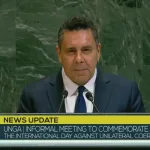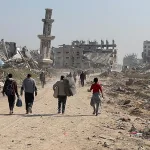
By Kit Klarenberg – Mar 30, 2024
Contrary to their mainstream portrayal, as inspired purely by religious fundamentalism, Daesh are primarily guns for hire.
Within just 24 hours of the horrific mass shooting in Moscow’s Crocus City Hall on March 22nd, which left at least 137 innocent people dead and 60 more critically wounded, US officials blamed the slaughter on ISIS-K, Daesh’s South-Central Asian branch. For many, the attribution’s celerity raised suspicions Washington was seeking to decisively shift Western public and Russian government focus away from the actual culprits – be that Ukraine, and/or Britain, Kiev’s foremost proxy sponsor.
Full details of how the four shooters were recruited, directed, armed, and financed, and who by, are yet to emerge. The savage interrogation methods to which they have been, and no doubt continue to be subjected are concerned with prising this and other vital information from them. The killers may end up making false confessions as a result. In any event, they themselves likely have no clue who or what truly sponsored their monstrous actions.
Contrary to their mainstream portrayal, as inspired purely by religious fundamentalism, Daesh are primarily guns for hire. At any given time, they act at the behest of an array of international donors, bound by common interests. Funding, weapons, and orders reach its fighters circuitously, and opaquely. There is almost invariably layer upon layer of cutouts between the perpetrators of an attack claimed by the group, and its ultimate orchestrators and financiers.
Given ISIS-K is currently arrayed against China, Iran, and Russia – in other words, the US Empire’s primary adversaries – it is incumbent to revisit Daesh’s origins. Emerging seemingly out of nowhere just over a decade ago, before dominating mainstream media headlines and Western public consciousness for several years before vanishing, at one stage the group occupied vast swaths of Iraqi and Syrian territory, declaring an “Islamic State”, which issued its own currency, passports, and vehicle registration plates.
Devastating military interventions independently launched by the US and Russia wiped out that demonic construct in 2017. The CIA and MI6 were no doubt immensely relieved. After all, extremely awkward questions about how Daesh were comprehensively extinguished. As we shall see, the terror group and its caliphate did not emerge in the manner of lightning on a dark night, but due to dedicated, determined policy hatched in London and Washington, implemented by their spying agencies.
‘Continuingly Hostile’
RAND is a highly influential, Washington DC-headquartered “think tank”. Bankrolled to the tune of almost $100 million annually by the Pentagon and other US government entities, it regularly disseminates recommendations on national security, foreign affairs, military strategy, and covert and overt actions overseas. These pronouncements are more often than not subsequently adopted as policy.
For example, a July 2016 RAND paper on the prospect of “war with China” forecast a need to fill Eastern Europe with US soldiers in advance of a “hot” conflict with Beijing, as Russia would undoubtedly side with its neighbour and ally in such a dispute. It was therefore necessary to tie down Moscow’s forces at its borders. Six months later, scores of NATO troops duly arrived in the region, ostensibly to counter “Russian aggression”.
Similarly, in April 2019 RAND published Extending Russia. It set out “a range of possible means” to “bait Russia into overextending itself,” so as to “undermine the regime’s stability.” These methods included; providing lethal aid to Ukraine; increasing US support for the Syrian rebels; promoting “regime change in Belarus”; exploiting “tensions” in the Caucasus; neutralising “Russian influence in Central Asia” and Moldova. Most of that came to pass thereafter.
In this context, RAND’s November 2008 Unfolding The Long War makes for disquieting reading. It explored ways the US Global War on Terror could be prosecuted once coalition forces formally left Iraq, under the terms of a withdrawal agreement inked by Baghdad and Washington that same month. This development by definition threatened Anglo dominion over Persian Gulf oil and gas resources, which would remain “a strategic priority” when the occupation was officially over.
Ex-Isis Chief Appointed as Commander of US-Backed Militia in Syria
“This priority will interact strongly with that of prosecuting the long war,” RAND declared. The think tank went on to propose a “divide and rule” strategy to maintain US hegemony in Iraq, despite the power vacuum created by withdrawal. Under its auspices, Washington would exploit “fault lines between [Iraq’s] various Salafi-jihadist groups to turn them against each other and dissipate their energy on internal conflicts”, while “supporting authoritative Sunni governments against a continuingly hostile Iran”:
“This strategy relies heavily on covert action, information operations, unconventional warfare, and support to indigenous security forces…The US and its local allies could use nationalist jihadists to launch proxy campaigns to discredit transnational jihadists in the eyes of the local populace…This would be an inexpensive way of buying time…until the US can return its full attention to the [region]. US leaders could also choose to capitalize on the sustained Shia-Sunni Conflict…by taking the side of conservative Sunni regimes against Shiite empowerment movements in the Muslim world.”
‘Great Danger’
So it was that the CIA and MI6 began supporting “nationalist jihadists” throughout West Asia. The next year, Bashar Assad rejected a Qatari proposal to route Doha’s vast gas reserves directly to Europe, via a $10 billion, 1,500 kilometre-long pipeline spanning Saudi Arabia, Jordan, Syria and Turkey. As extensively documented by WikiLeaks-released diplomatic cables, US, Israeli and Saudi intelligence immediately decided to overthrow Assad by fomenting a local rebellion, and started financing opposition groups for the purpose.
This effort became turbocharged in October 2011, with MI6 redirecting weapons and extremist fighters from Libya to Syria, in the wake of Muammar Gaddafi’s televised murder. The CIA oversaw that operation, using the British as an arm’s length cutout to avoid notifying Congress of its machinations. Only in June 2013, with then-President Barack Obama’s official authorisation, did the Agency’s cloak-and-dagger connivances in Damascus become formalised – and later admitted – under the title “Timber Sycamore”.
At this time, Western officials universally referred to their Syrian proxies as “moderate rebels”. Yet, Washington was well-aware its surrogates were dangerous extremists, seeking to carve a fundamentalist caliphate out of the territory they occupied. An August 2012 US Defense Intelligence Agency (DIA) report released under Freedom of Information laws observes that events in Baghdad were “taking a clear sectarian direction,” with radical Salafist groups “the major forces driving the insurgency in Syria.”
These factions included Al Qaeda’s Iraqi wing (AQI), and its umbrella offshoot, Islamic State of Iraq (ISI). The pair went on to form Daesh, a prospect the DIA report not only predicted, but seemingly endorsed:
“If the situation unravels, there is the possibility of establishing a declared or undeclared Salafist principality in eastern Syria…This is exactly what the supporting powers to the opposition want in order to isolate the Syrian regime…ISI could also declare an Islamic state through its union with other terrorist organizations in Iraq and Syria, which will create great danger.”
Despite such grave concerns, the CIA inexorably dispatched unaccountably vast shipments of weapons and money to Syria’s “moderate rebels”, well-knowing this “aid” would almost inevitably end up in Daesh’s hands. Moreover, Britain concurrently ran secret programs costing millions to train opposition paramilitaries in the art of killing, while providing medical assistance to wounded jihadists. London also donated multiple ambulances, purchased from Qatar, to armed groups in the country.
Leaked documents indicate the risk of equipment and trained personnel from these efforts being lost to Al-Nusra, Daesh, and other extremist groups in West Asia was judged unavoidably “high” by British intelligence. Yet, there was no concomitant strategy for countering this hazard at all, and the illicit programs continued apace. Almost as if training and arming Daesh was precisely the desired outcome.
- Orinoco Tribune 2https://orinocotribune.com/author/yullma/
- Orinoco Tribune 2https://orinocotribune.com/author/yullma/
- Orinoco Tribune 2https://orinocotribune.com/author/yullma/
- Orinoco Tribune 2https://orinocotribune.com/author/yullma/December 5, 2025






